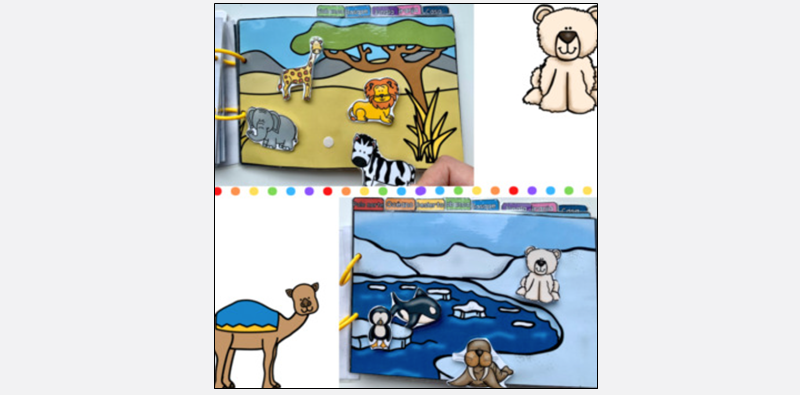Leer/To read
WAYS WE CAN USE THE WORD
SHARE INFORMATION: e.g. Me gusta leer. (I like to read.)
REQUEST: e.g. ¿Podemos leer un libro? (Can we read a book?)
COMMENT: e.g. Me gusta mucho leer. (I like to read very much.)
REQUESTING HELP: e.g. ¿Me puedes leer lo que dice aqui? (Can you read me what it says here?)
CONJUGATIONS PRESENT AND PAST (PRETÉRITO INDEFINIDO)
|
Subject Pronouns |
Present |
Past |
|
I |
Leo |
Leí |
|
You |
Lees |
Leiste |
|
He/she/you (formal) |
Lee |
Leyó |
|
We |
Leemos |
Leímos |
|
They/you all |
Leen |
Leyeron |
This activity sheet was adapted from the School Year of Core Words activities for “read” by Michaela Sullivan @ michaelasullivan2@gmail.com. For specific questions or more ideas regarding this core word activity sheet, please contact Isabel Medina @ imedina@sfsu.edu. Thank you!
Beginning of day: Adults can model the core word and ask students to read what is on the board or read it as a class e.g. Vamos a leer el pizarrón (We are going to read the board) or Puedes leer lo que está en el pizarrón? (Can you read what is on the board?).
Circle: Students can use the core word and ask the adults e.g Cual libro vamos a leer? (What book are we going to read?) and can give suggestions when asked by the adult e.g. Yo quiero leer____. (I want to read____.)

Pretend Play: After reading a book, students can act the different scenes in the book, pretend to be characters in the book, role-play and make sound effects related to the book (Animals, vehicles, etc) e.g. “Despues de leer el libro, todos vamos a pretender ser diferentes animales” (After we read the book, were all going to pretend we are different animals).
Here are some suggested books on YouTube that can assist in teaching the core word:
- Yo Puedo Leer Con Los Ojos Cerrados By Dr. Seuss
- This a book in Spanish that follows Cat in the Hat describing all the things that are great about reading and encourages children to be proud of their reading skills because of all the knowledge it brings.
- Roc Aprende a Leer By Tad Hills
- This is a book in Spanish that follows the story of a dog named Roc who discovers the ability to connect letters, make words and create meaning as well as read stories all by himself.
- Lola en la Biblioteca By Anna McQuinn and Rosalind Beardshaw
- This book in Spanish follows Lola on her weekly adventure to the library with her mom. It is a story about growing with books and it encourages children to discover the joy of reading and all the small adventures on the way (packing up her backpack and library card, singing, choosing books, and her walk home with her mom).
Social Interactions
Students can each pick a book to read and take turns reading their book to each other e.g. “Quieres leer mi libro?” (Do you want to read my book?).
Students can also choose their preferred book and engage in reading a book together, taking turns reading each page and pointing out their favorite parts. Students can use the core word to invite another peer/adult to read with them. “Quieres leer este libro conmigo?” (Do you want to read this book with me?” “Vamos a leer my libro y luego tu libro” (Let’s read my book and then yours), “Mi turno de leer” (My turn to read).
Video Modeling
- Read Aloud: René Has Two Last Names By René Colato Laínez
- Read aloud in Spanish and English
- AAC Reading ‘Good Boy Fergus’ By David Shannon
- Example in English of reading aloud using AAC and targeting core words, Students can read book with peer/adults similar to this model.
Sensory book: Students can put together a sensory book with different textures using felt, velcro, string, buttons, and glue. Students can then share their books with each other and read to each other e.g., “¿Puedo leer tu libro?” (Can I read your book?), “Me gustó leer to libro!” (I liked reading your book!).
Walk in community/school: While on a walk in the community or around school, Adults can model the core word by reminding students when a street sign or any important sign is in view e.g. “Acuerdate, tenemos que leer el letrero del nombre de la calle” (Remember, we have to read the sign for the street names), “Antes de entrar a este cuarto, tenemeos que leer el letrero y ver si esta ocupado o no” (Before we go into this room, we have to read the sign and see if its busy or not.”
- Me Gusta Leer
- A Mi Me Gusta Leer - RockAlingua
- Leer Los Letreros Cada Dia
- Video example of a family modeling reading street signals out in the community
Dialogic Reading: Adults can lead a group of 3-5 student in reading a book using Dialogic Reading approaches. Dialogic Reading is an active-engaged type of shared reading. It helps support the development of vocabulary, overall language skills, attention, interest in books, critical thinking and more. It involves steps such as:
Completion prompting – Adults begins a phrase and student completes it e.g. “Esto es una ___” (This is a ____).
Asking simple WH questions during a book e.g “Que está haciendo el niño en esta foto?” (What is the boy doing in this picture?)
Asking more open ended questions e.g. “Que ves en esta pagina?” (What do you see on this page?), “Que esta pasando en esta parte de el cuento?” (What is happening in this part of the story?)
Connecting what is happening in the story with what is happening in the child’s life or things in the classroom, building up a narrative, recalling information from beginning of book, etc. e.g.“¿Que pasó al principio del cuento?” (What happened at the beginning of the story?).
Some possible bilingual books in English/Spanish to use with Dialogic Reading:
- My Colors, My World/ Mis Colores, Mi Mundo
- Señorita Mariposa
- Song and Coloring: “A Mi Me Gusta Leer”
After listening to this song about reading, Students can complete this coloring page in Spanish that follows the song.

Students can create their own personalized bookmarks to use throughout the school year. These can be created using different art supplies, paper mache, string, etc. Students can use the core word to describe what book they will ready and use their bookmark with “Voy a poner mi marcador en ese libro que voy a leer mañana!” (I’m going to put my bookmark in that book that I will read tomorrow!).

Adults can create a lesson surrounding animals and their different habitats then students can create their own book using this activity. Students can read their book to each other and point out where they added each animal.

FlipHTML5 – Online Book Creator: This is an online book creator that can be changed in the language section to
include Spanish.
My Storybook – Online Book Creator: This is an online book creator in English, you are able to add any text you want
to include Spanish and create a story using the core word.
Book Creator: This website is an online book creator where the user is able to create a story. It is available in Spanish.
WORD WALL: Create a WordWall and add ‘LEER’ to the list.
READING and the Word Wall: Sound out the letters of “leer” together. Have the students find the word on the AAC system.
WRITING and the Word Wall: Using a pencil or alternative pencil, have students try to type the word on the keyboard or write the word together.